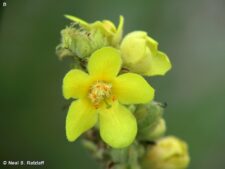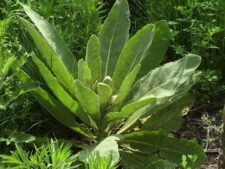
WOOLLY MULLEIN
Verbascum thapsus
FIGWORT FAMILY (Scrophulariaceae)
 Identification
Identification
- Flowering time - July, August, September
- Common in disturbed soil at both FF and NW
- Soft, woolly leaves
- Stout, erect stem with many yellow, 5-petaled flowers
- Stalks often remain standing through the winter
This naturalized biennial was introduced from Europe and is considered a weed in Nebraska. During the first year a large rosette of woolly leaves forms (D). The second year an erect stem, 4-8 feet tall, shoots up. It has woolly leaves and one or more stiff flowering spikes with densely crowded flowers; each has 5 petals and 5 stamens with orange tips (A,B,C). The dried stalks and attached seed capsules often remain standing through the fall and winter.
Found along roadsides and disturbed soil, flowering from July through September. It is common in disturbed sites at both Fontenelle Forest and Neale Woods.
The various uses of this plant date back to the Romans, who dipped the flowering spikes in grease and used them as torches. Early settlers and Native Americans used the leaves for insulation by lining their stockings and moccasins.
It has a host of other common names including Flannel Mullein, Candlewick, Velvet Plant and Hare’s Beard.
The content of NatureSearch is provided by dedicated volunteer Naturalists of Fontenelle Forest who strive to provide the most accurate information available. Contributors of the images retain their copyrights. The point of contact for this page is: Roland Barth.



